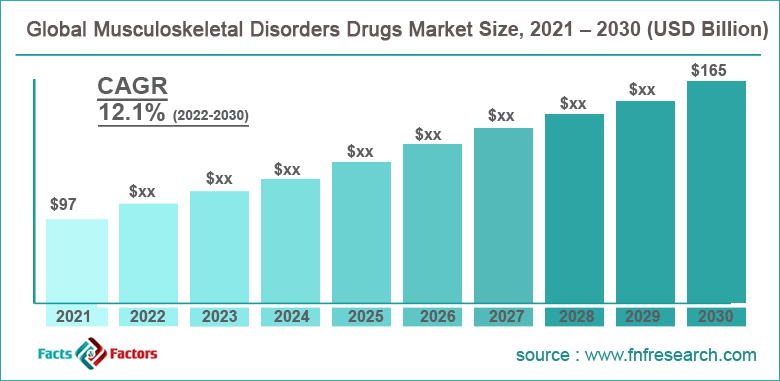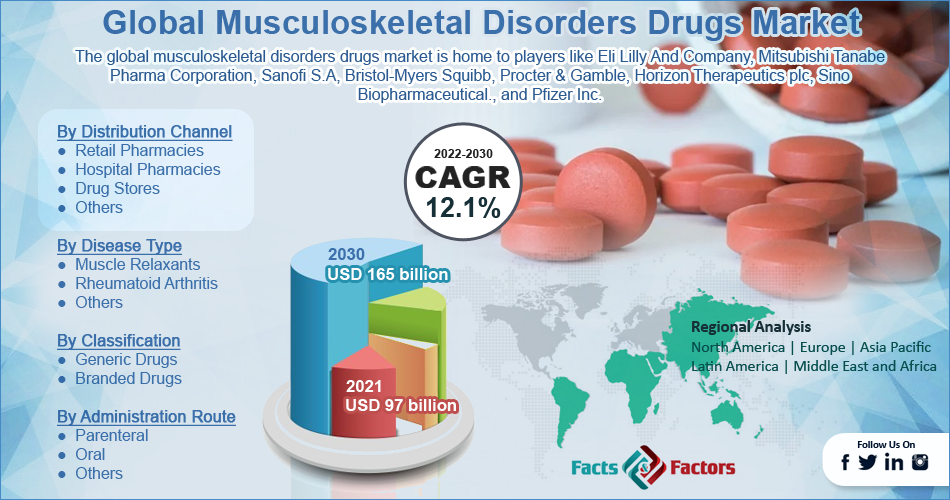Search Market Research Report
Musculoskeletal Disorders Drugs Market Size, Share Global Analysis Report, 2022 – 2030

Musculoskeletal Disorders Drugs Market Size, Share, Growth Analysis Report By Distribution Channel (Retail Pharmacies, Hospital Pharmacies, Drug Stores, and Others), By Disease Type (Muscle Relaxants, Rheumatoid Arthritis, and Others), By Classification (Generic Drugs, and Branded Drugs), By Administration Route (Parenteral, Oral, and Others), and By Region - Global and Regional Industry Insights, Overview, Comprehensive Analysis, Trends, Statistical Research, Market Intelligence, Historical Data and Forecast 2022 – 2030
Industry Insights
[229+ Pages Report] According to the report published by Facts Factors, the global musculoskeletal disorders drugs market size was worth around USD 97 billion in 2021 and is predicted to grow to around USD 165 billion by 2030 with a compound annual growth rate (CAGR) of roughly 12.1% between 2022 and 2030. The report analyzes the global musculoskeletal disorders drugs market drivers, restraints/challenges, and the effect they have on the demands during the projection period. In addition, the report explores emerging opportunities in the musculoskeletal disorders drugs market.

 Market Overview
Market Overview
Musculoskeletal systems comprise body organs like ligaments, cartilage, bones, connective tissues, and tendons. The skeleton is a necessary framework for soft tissues and muscles. These components together support the body weight and help in maintaining posture and body movement. Different types of conditions and disorders can cause issues in the musculoskeletal system.
Factors like birth defects, injuries, aging, and other diseases influence the movement of the body and pain. There are 6 main components of the system. The first is bones. They differ in size and shape but each one of them is necessary for supporting the body, protecting the organs, and tissues, and storing calcium. They also regulate the production of blood cells. They work together with ligaments, tendons, muscles, and connective tissues.
One such tissue is cartilage which is used to provide cushioning to the bones present inside the spine, ribcage, and joints. They can also be present in the pelvis, lungs, nose, and ears. Joints are formed when bones come together. Some may have a larger range of motion while some may not rotate, like elbow bones. Muscles are made of a large number of stretchy fibers coming together. They are used to carry out normal day-to-day tasks like talking, writing, and swallowing. Ligaments and tendons are an equally important part of the musculoskeletal group.
 Key Insights
Key Insights
- As per the analysis shared by our research analyst, the global musculoskeletal disorders drugs market is estimated to grow annually at a CAGR of around 12.1% over the forecast period (2022-2030)
- In terms of revenue, the global musculoskeletal disorders drugs market size was valued at around USD 97 billion in 2021 and is projected to reach USD 165 billion, by 2030.
- The market is projected to grow at a significant rate due to the growing elderly population
- Based on distribution type segmentation, retail pharmacies were predicted to show maximum market share in the year 2021
- Based on classification segmentation, branded drugs were the leading type in 2021
- On the basis of region, North America was the leading revenue generator in 2021

 Growth Drivers
Growth Drivers
- Increasing number of the elderly population to propel market demand
The global musculoskeletal disorders drugs market is projected to grow owing to the increasing number of elderly populations across the world. Although there are multiple factors that can influence the onset of the disorder, it is most commonly observed in people aged over 60 years. Due to the age, the duration required to cure the issues is relatively longer and limited resources, which means that the risk associated with the illness is very high in senior citizens.
As per the estimates by the World Health Organization (WHO), 1 in every 6 people will be over the age of 60 years by the end of 2030. The organization has also claimed that the pace of aging has become faster than it was in the past between 2015 and 2050, the elderly population is expected to double between 12% and 22%. Some countries have already recorded a high percentage of the elderly population.
For instance, in Japan, the number is as high as 30%. The most common musculoskeletal disorder in people over 60 years of age is osteoarthritis (OA) which is highly prevalent in the male population at 90% and in women, it is around 80%. Due to the correlation between age and muscle-related disorders, the drugs and medical care related to these diseases are expected to grow at a high CAGR.
 Restraints
Restraints
- Growing concern over the effectiveness of the drugs to restrict market expansion
The global market may face growth restrictions owing to the increasing doubts amidst the medical unit about the effectiveness of the drugs or medical therapies used to treat the disorder. For instance, a recent study has claimed that non-steroidal anti-inflammatory drugs (NSAIDs), one of the most commonly used drugs for musculoskeletal disorders, could be making the condition worse. However, more research is needed to come to a conclusion. Most of the drugs included in the category are naproxen, ibuprofen, and aspirin.
 Opportunities
Opportunities
- Increasing innovation and development to provide growth opportunities
The global musculoskeletal disorders market is anticipated to witness high growth opportunities due to the growing investments in research & development of new drugs that can control the side effects associated with the current drugs in use. As the medical and healthcare sector is extremely important for the survival of living organisms, the industry is witnessing a surge in interest from private and government bodies to conduct large-scale research on the development of more effective drugs as the approval regulations from the food administration and drug authorities become more strict.
 Challenges
Challenges
- High cost to act as a challenging factor for market growth
Drugs associated with the treatment of musculoskeletal disorders are expensive, rendering them unaffordable for a large segment of society, especially in underdeveloped or developing economies. There is also a significant gap between the demand and supply of necessary healthcare infrastructure which means that quality healthcare remains inaccessible to the majority of the global population.
 Segmentation Analysis
Segmentation Analysis
The global musculoskeletal disorders drugs market is segmented based on distribution channel, disease type, classification, administration route, and region.
Based on distribution channel, the global market segments are retail pharmacies, hospital pharmacies, drug stores, and others. The global market witnessed the highest growth in retail pharmacies as the demand for the drugs increased dramatically during Covid-19. Various inflammatory molecules associated with Covid-19 infection like IL-17, IL-1β resulted in a decreased response of the muscles and reduced endurance along with an increase in bone fragility. There are more than 150 types of musculoskeletal diseases that can severely impact the proper functioning of the systems involved.
Based on the classification, the global market segments are generic drugs and branded drugs. In the developed economies, the demand for branded drugs remained high in 2021 due to the presence of a set population that can afford the high cost of branded drugs. However, in developing economies, the low-income group chose generic medicines over their counterparts due to cost-effectiveness. As estimated, generic medicines cost 85% less than branded medicines and have the same effect.
 Recent Developments:
Recent Developments:
- In October 2021, Australia witnessed a new musculoskeletal research program with a collaboration between Sydney Local Health District, the University of Sydney, and North Sydney Local Health District. This program will link researchers and clinicians from across these institutes to make significant contributions
- In August 2020, the U.S FDA approved the use of Evrysdi, in oral treatment, for spinal muscular atrophy, a rare genetic disorder
 Report Scope
Report Scope
Report Attribute |
Details |
Market Size in 2021 |
USD 97 Billion |
Projected Market Size in 2030 |
USD 165 Billion |
CAGR Growth Rate |
12.1% CAGR |
Base Year |
2021 |
Forecast Years |
2022-2030 |
Key Market Players |
Eli Lilly And Company, Mitsubishi Tanabe Pharma Corporation, Sanofi S.A, Bristol-Myers Squibb, Procter & Gamble, Horizon Therapeutics plc, Sino Biopharmaceutical., Pfizer Inc., and others. |
Key Segment |
By Distribution Channel, Disease Type, Classification, Administration Route, and Region |
Major Regions Covered |
North America, Europe, Asia Pacific, Latin America, and the Middle East &, Africa |
Purchase Options |
Request customized purchase options to meet your research needs. Explore purchase options |
 Regional Analysis
Regional Analysis
- North America to lead with the highest CAGR
The global musculoskeletal disorders drugs market is projected to witness the highest growth in North America owing to the advanced healthcare infrastructure of the US and Canada. As these regions are equipped with exceptionally high standards of medical care, more people have access to quality drugs.
Other factors like medical reimbursement policies, easy availability, and access to prescription drugs contribute to regional growth. The U.S. FDA, the country’s regional drug administration authority, has increased the number of approvals in the last few years owing to the growing efforts undertaken by the market players to research and develop high-grade and effective medicines. The institute, at the same time, is stringent with its policies which means that only safe products circulate in the market. In 2021, the Center For Drugs Evaluation and Research approved more than 50 types of new drugs.
 Competitive Analysis
Competitive Analysis
- Eli Lilly And Company
- Mitsubishi Tanabe Pharma Corporation
- Sanofi S.A
- Bristol-Myers Squibb
- Procter & Gamble
- Horizon Therapeutics plc
- Sino Biopharmaceutical
- Pfizer Inc.
The global musculoskeletal disorders drugs market is segmented as follows:
 By Distribution Channel Segment Analysis
By Distribution Channel Segment Analysis
- Retail Pharmacies
- Hospital Pharmacies
- Drug Stores
- Others
 By Disease Type Segment Analysis
By Disease Type Segment Analysis
- Muscle Relaxants
- Rheumatoid Arthritis
- Others
 By Classification Segment Analysis
By Classification Segment Analysis
- Generic Drugs
- Branded Drugs
 By Administration Route Segment Analysis
By Administration Route Segment Analysis
- Parenteral
- Oral
- Others
 By Regional Segment Analysis
By Regional Segment Analysis
- North America
- The U.S.
- Canada
- Mexico
- Europe
- France
- The UK
- Spain
- Germany
- Italy
- Nordic Countries
- Denmark
- Sweden
- Norway
- Benelux Union
- Belgium
- The Netherlands
- Luxembourg
- Rest of Europe
- Asia Pacific
- China
- Japan
- India
- Australia
- South Korea
- Southeast Asia
- Indonesia
- Thailand
- Malaysia
- Singapore
- Rest of Southeast Asia
- Rest of Asia Pacific
- The Middle East & Africa
- Saudi Arabia
- UAE
- Egypt
- South Africa
- Rest of the Middle East & Africa
- Latin America
- Brazil
- Argentina
- Rest of Latin America
Industry Major Market Players
- Eli Lilly And Company
- Mitsubishi Tanabe Pharma Corporation
- Sanofi S.A
- Bristol-Myers Squibb
- Procter & Gamble
- Horizon Therapeutics plc
- Sino Biopharmaceutical
- Pfizer Inc.
Frequently Asked Questions

Copyright © 2023 - 2024, All Rights Reserved, Facts and Factors


